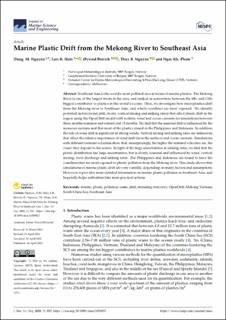| dc.contributor.author | Nguyen, Dung M. | |
| dc.contributor.author | Hole, Lars Robert | |
| dc.contributor.author | Breivik, Øyvind | |
| dc.contributor.author | Nguyen, Thuy B. | |
| dc.contributor.author | Pham, Ngoc Kh. | |
| dc.date.accessioned | 2023-06-30T10:59:14Z | |
| dc.date.available | 2023-06-30T10:59:14Z | |
| dc.date.created | 2023-06-16T14:28:21Z | |
| dc.date.issued | 2023-04-26 | |
| dc.identifier.issn | 2077-1312 | |
| dc.identifier.uri | https://hdl.handle.net/11250/3074707 | |
| dc.description.abstract | Southeast Asia is the world’s most polluted area in terms of marine plastics. The Mekong River is one of the largest rivers in the area, and ranked as somewhere between the 8th- and 11th-biggest contributor to plastics in the world’s oceans. Here, we investigate how microplastics drift from the Mekong river to Southeast Asia, and which coastlines are most exposed. We identify potential factors (wind drift, rivers, vertical mixing and sinking rates) that affect plastic drift in the region using the OpenDrift model with realistic wind and ocean currents for simulations between three months (summer and winter) and 15 months. We find that the seasonal drift is influenced by the monsoon systems and that most of the plastics strand in the Philippines and Indonesia. In addition, the role of wind drift is significant in strong winds. Vertical mixing and sinking rates are unknowns that affect the relative importance of wind drift (near the surface) and ocean currents. Simulations with different terminal velocities show that, unsurprisingly, the higher the terminal velocities are, the closer they deposit to the source. In light of the large uncertainties in sinking rates, we find that the plastic distribution has large uncertainties, but is clearly seasonal and influenced by wind, vertical mixing, river discharge and sinking rates. The Philippines and Indonesia are found to have the coastlines that are most exposed to plastic pollution from the Mekong river. This study shows that simulations of marine plastic drift are very variable, depending on many factors and assumptions. However, it provides more detailed information on marine plastic pollution in Southeast Asia, and hopefully helps authorities take more practical actions. | en_US |
| dc.language.iso | eng | en_US |
| dc.publisher | MDPI | en_US |
| dc.rights | Navngivelse 4.0 Internasjonal | * |
| dc.rights.uri | http://creativecommons.org/licenses/by/4.0/deed.no | * |
| dc.title | Marine Plastic Drift from the Mekong River to Southeast Asia | en_US |
| dc.type | Journal article | en_US |
| dc.type | Peer reviewed | en_US |
| dc.description.version | publishedVersion | en_US |
| dc.rights.holder | Copyright 2023 the authors | en_US |
| dc.source.articlenumber | 925 | en_US |
| cristin.ispublished | true | |
| cristin.fulltext | original | |
| cristin.qualitycode | 1 | |
| dc.identifier.doi | 10.3390/jmse11050925 | |
| dc.identifier.cristin | 2155319 | |
| dc.source.journal | Journal of Marine Science and Engineering | en_US |
| dc.relation.project | NORAD, direktoratet for utviklingssamarbeid: RAS-2820 RAS-17/0009 (BMV ) | en_US |
| dc.identifier.citation | Journal of Marine Science and Engineering. 2023, 11 (5), 925. | en_US |
| dc.source.volume | 11 | en_US |
| dc.source.issue | 5 | en_US |

